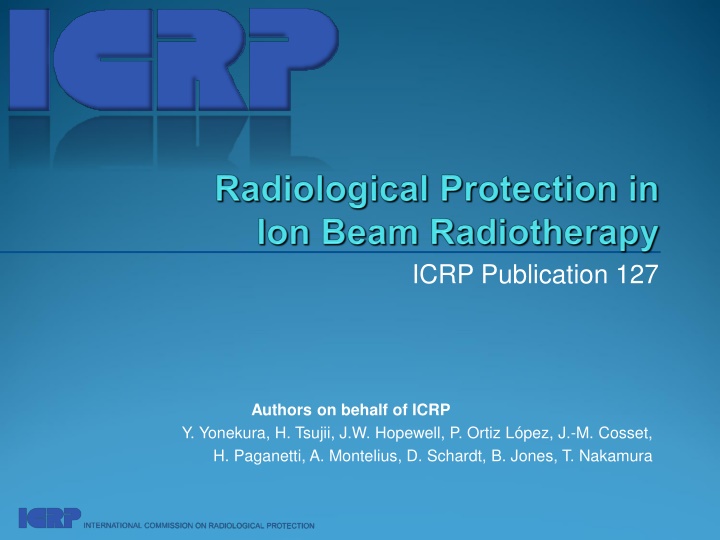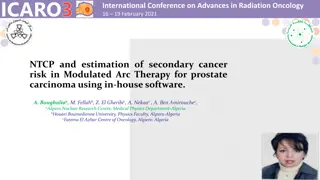Advancements in Ion Beam Radiotherapy for Cancer Treatment
Ion beam radiotherapy, utilizing protons and carbon ions, offers precise dose localization with minimal damage to normal tissues, leading to effective treatment of solid cancers. This document discusses the benefits, challenges, and safety considerations of ion beam therapy, highlighting its significant role in modern cancer treatment.
Download Presentation

Please find below an Image/Link to download the presentation.
The content on the website is provided AS IS for your information and personal use only. It may not be sold, licensed, or shared on other websites without obtaining consent from the author.If you encounter any issues during the download, it is possible that the publisher has removed the file from their server.
You are allowed to download the files provided on this website for personal or commercial use, subject to the condition that they are used lawfully. All files are the property of their respective owners.
The content on the website is provided AS IS for your information and personal use only. It may not be sold, licensed, or shared on other websites without obtaining consent from the author.
E N D
Presentation Transcript
ICRP Publication 127 Authors on behalf of ICRP Y. Yonekura, H. Tsujii, J.W. Hopewell, P. Ortiz L pez, J.-M. Cosset, H. Paganetti, A. Montelius, D. Schardt, B. Jones, T. Nakamura
1. Introduction 2. Outline of Ion Beam Radiotherapy 3. Physical Issues for Radiological Protection 4. Radiobiological Implications 5. Radiation Exposure in Ion Beam Radiotherapy 6. Radiation Safety Management for Ion Beam Radiotherapy Facilities 7. Preventing Accidental Exposures of Patient from Ion Beam Radiotherapy 8. Conclusions and Recommendations 4
Publication 86 (2000): Prevention of accidental exposure to patients undergoing radiation therapy. Publication 112 (2009): Preventing accidental exposures from new external beam radiation therapy technologies. 5
Ion beams are considered to have the optimum properties in dose localisation. Benefits of ion beam therapy can be achieved in patients with solid cancer with defined borders. Ion beam radiotherapy with protons and carbon ions has gained increasing interest and has expanded rapidly in the last decade. This document reviews the present status and problems of the use of ion beam radiotherapy from the viewpoints of radiological protection and safety, and provides practical guidance for the effective and safe use of ion beams for medical treatment for benign and malignant disease. 6
External beam radiotherapy relies on precise dose localisation in the target treatment volume with minimal damage to the surrounding normal tissues. The success of treatment largely depends on the performance and capacity of accelerators, its beam delivery system and the quality of the treatment planning systems used. The clinical use of ion beams, such as protons and carbon ions, provides precise dose distributions due primarily to their finite range in tissue. Such precise deposition of energy in tumour volumes enables a significant reduction in radiation exposure to uninvolved normal tissues. 7
The clinical advantage of ion beam radiotherapy results from the manner in which protons and carbon ions lose their energy in tissue. Much of their energy is lost near the end of their range in tissue. This peak of energy loss or stopping power is called the Bragg peak. This physical phenomenon is exploited in ion beam therapy of cancer to achieve a higher absorbed dose within the tumour than in the surrounding healthy tissues. 8
The relative biological effectiveness (RBE) values for different ions vary for different endpoints but tend to increase with increments of stopping power or linear energy transfer (LET) up to a maximum value before declining. Clinically used proton beams are low-LET radiations, hence the RBE values are very close to that of high energy X-rays. For a given biological endpoint, carbon ions have higher RBE values than protons and increase with depth and have their maximum near the depth where the Bragg peak occurs. 9
An ion beam delivery system generally consists of an accelerator, a transport beam line and an irradiation system, where dose is delivered to the patient with either a narrow beam (pencil beam scanning method) or a broadened beam (broad beam method). When ion beams pass through or hit these beam line structures, secondary radiations including neutrons are produced, and some of the particles in the structures can become radioactive and form an autoradioactive component of the beam. 10
The first step for ion beam radiotherapy, similarly to any medical procedures, is justification. The proper selection of the patient should be based on knowledge of radiation oncology, the specific tumour to be treated and available clinical results to provide the optimal benefit to the patient. 11
Careful treatment planning is required for optimisation to maximise the efficiency of treatment and minimise the dose to normal tissues, and depends on the treatment method and the targeted tumour. Theoretically, ion beam radiotherapy delivers radiation dose more efficiently to the target volume than conventional radiotherapy while minimising the undesired exposure to normal tissues. Nonetheless, the treatment planning must be sufficiently precise to avoid damaging the critical organs or tissues within or near the target. 12
Doses in the out-of-field volumes arise from the secondary neutrons and photons, particle fragments, and photons from activated materials. These undesired but unavoidable doses should be considered from the standpoint of radiological protection. Secondary neutrons are the major contributor to absorbed dose in the areas distant from the treatment volume. The pencil beam scanning method can minimise this type of radiation exposure. 13
Imaging procedures are essential in treatment planning as similar to other modern radiotherapies, and deliver additional small radiation dose to the patient. 14
Appropriate management is required for the therapy equipment and also for the air in the treatment room which is activated. Management should always be in conformity with criteria of the regulatory agency. The current regulations for occupational exposures in photon radiotherapy are applicable to ion beam radiotherapy with protons or carbon ions. 15
After treatment with ion beams, the patient will be slightly radioactive for a short time. However, radiation exposure to family members of the patients and caretakers as well as to the public due to this activation is negligible, and no specific protection procedures are required after the patient is released. The methods of radiological protection for public exposures in photon radiotherapy facilities are applicable to and adequate for ion beam radiotherapy facilities. 16
Because ion beam radiotherapy requires a more complex treatment system than conventional radiotherapy, appropriate training of the staff and suitable quality assurance programmes are essential to avoid possible accidental exposure to the patient. 17
Optimize the treatment Provide sufficient dose to the target tumor. Minimize the effects in surrounding normal tissues. Safety culture to avoid accidental exposure New treatment methods are often associated with complicated procedures. Biological effects appear in the later period. Need for long term follow up of the late effects Longer survival of the patients increases the risk of second malignancy. Low dose exposure in large area of normal tissues Protection of personnel 18
Radiation safety management for the facilities Management of exposure due to activation of devices Management of radioactivity due to activated nuclides Monitoring air concentration Discharge of air from the radiotherapy facilities Management of solid waste Patient Monitoring system for management of radiological protection Quality assurance in management of radiological protection of the facilities (These are the key elements of Chapter 6, and it is advised to go through the full publication for detailed information.) 19
New technologies in RT brought highly conformal dose distribution, but even subtle errors during the treatment process would easily bring severe consequences. In order to avoid accidental exposures, there is a need for prospective, structured and systematic approaches to identify system weakness (see Table 7.1). Disseminating knowledge and lessons learned from previous accidental exposures is crucial in preventing re- occurrence. Comprehensive QA programme can lead to detect systematic errors, and decrease the frequency and severity of random errors. 20
Ion beam radiotherapy provides excellent dose distribution to the targeted tumour, and the proper selection of the patient should be the first step for justification of the treatment to provide the optimal benefit to the patient. Careful treatment planning is required for optimisation to maximise the efficiency of treatment and to minimise the dose to normal tissues. The treatment planning must be sufficiently precise to avoid damaging critical organs or tissues within or near the target volume. Ion beam delivery system consists of accelerator, high energy beam transporter and irradiation system. When ion beams pass through or hit these beam line structures, secondary neutrons and photons can be produced, as well as particle fragments and photons from the activated materials. These doses should be considered from the standpoint of radiological protection. 21
Appropriate management is required for the therapy equipment and also for the air in the treatment room which is activated. After the treatment, the patient is also a radioactive source for a short period. However, radiation exposure to family members or public is small, and no specific care is required. Ion beam radiotherapy requires complicated treatment system, and extensive training of the staff and adequate quality assurance programme are recommended to avoid possible accidental exposure to the patient. Incorporating lessons from past accidental exposures into training is crucial to prevent reoccurrence. A number of generic lessons in photon radiotherapy may be applicable to ion beam radiotherapy. This retrospective approach should be complemented with prospective methods for identification of system weaknesses and their prevention. 22
ICRP, 2014. Radiological Protection in Ion Beam Radiotherapy. ICRP Publication 127. Ann. ICRP 43 (4). 23
www.icrp.org 24























